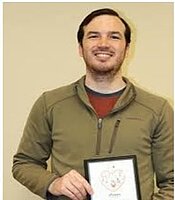Holocene Palaeoflood and Glacial Isostatic Adjustment (GIA) Influence on Fluvial Geomorphology of the Red River Basin

Zachary Phillips is a Ph.D student in the Environmental and Conservation Sciences Program and Geosciences Department at North Dakota State University. He holds a B.S. in Geological Sciences from Ohio State University studying earthquakes in Ohio and a M.S. in Geoenvironmental Studies from Shippensburg University studying fluvial response to dam removals and river restoration methods. His present research topic regards the Holocene erosion of post-glacial rivers (i.e the Red River and the Minnesota River) that are impacted by Glacial Isostatic Adjustments (GIA). The focus of this research is to better understand and model river erosion over the Holocene given the climate and GIA history of the region and develop methods for improving the study of rivers using high-precision remote sensing data as to support conservation, water resource management, and river restoration efforts.
Email: Zachary.Phillips@ndsu.edu
Phone: 513-280-1349
Fellow: Zachary R. Phillips
Adviser: Stephanie Day
Holocene Palaeoflood and Glacial Isostatic Adjustment (GIA) Influence on Fluvial Geomorphology of the Red River Basin
My research studies the responses of post-glacial rivers to climate change, post-Glacial Isostatic Adjustments (GIA), changing sediment characteristics, and human impacts using the Red River as a case study. I use interdisciplinary methods of interpreting fluvial systems and deposits as they correlate to the Holocene and late-Pleistocene history. This fellowship year, I explored the Red River’s floodplain topography using Geographic Information Systems (GIS) and developed a set of methods to extract areas of meander-cutoff topography from the Digital Elevation Model (DEM). I used the spatial distribution of the meander-cutoffs, as well as their relief and distance from the modern channel (DMC), as interpretive tools to suggest how meandering of the Red River has changed since the draining of Lake Agassiz. Result reporting is currently being conducted for this portion of my PhD project (Phillips and Day, 2018).
Currently, a Landscape Evolution Model (LEM) is being designed and assembled for the Red River Basin, with a focus on the evolution of the meandering path of the Red River. The LEM is being developed using the python-based LandLab modelling package, which will be used to simulate climate, hydrology, and geomorphology of the Red River Basin. Currently, the climate inputs are being assembled from the current literature and core libraries. Additionally, the DEM is being reconstructed to recreate the late-Pleistocene landscape prior to major elevational change from GIA. This model will depict the erosional history and future of the Red River basin and Red River Valley.
Work will begin this spring performing a series of geomorphic laboratory tests, using laser scanners to monitor fluvial erosion of clays with different water contents. These experiments are designed to simulate the drying and hardening of Sherak and Brenna Formations within the Red River Valley, and test the impacts of drying on erodibility. Lake Agassiz Clays will be used in the Geomorphology lab’s stream table, which of will be saturated and then dried for varying periods to differing levels of saturation. Then, the same experiment will be performed on each of the variably dried clays. Results are expected to show that wet clays erode more easily while dryer clays are less erodible.
Significance of Research
This research is significant because it helps people understand the modern effects of climate change and its interactions with rivers and humans. More specifically, regarding the Red River, this research is important because the Red River is a unique, clay-controlled meandering river which is both important and damaging to its floodplain residents. Being geomorphically clay-controlled, the Red River does not meander freely like typical rivers, which makes this an important rare case for which to gain a better understanding. In the southern Red River Valley, Fargo-Moorhead is attempting to harness floods near the F-M Urban area by establishing final plans and building a flood diversion. Building of a successful diversion relies on a thorough understanding of the geomorphology of the river, which has been studied more thoroughly north of the Canadian border. To date, there is no sure answer as to if the northern reaches of the Red River behave geomorphically similar to the southern Red River, but this research has and will continue better detail the Red River’s geomorphology and determine the major factors controlling Red River meandering of the past, present, and future.
Significant Findings
The major significant findings of this research are that there are ~158 meander-cutoffs on the Red River, which are skewed toward the south of the river. The widespread nature of low relief cutoffs, with meander-cutoffs being depositional locations, suggests that meandering used to be more active over the entire length of the river, but has slowed relatively recently as signified by the relatively few high-relief meander-cutoffs. High relief meander-cutoffs, that are interpreted as being younger than ~1520 calendar years before present, are present in only in two short, 20-km long reaches centered over top of the Edinburgh and Comstock moraines that were deposited in the Red River Valley by the Des Moines Lobe during the latePleistocene (Phillips and Day, 2018). This suggests that these underlying moraines may be influencing the modern morphology of the Red River in these reaches, something that was unknown prior to this research.
Publications
Phillips, Z.R. and Day, S.S. 2018. Exploring and interpreting the distribution of meandercutoffs of the post-glaciolacustrine Red River of the North, (in final stages of development for late-Spring 2018 submission to the) Journal of Earth Surfaces Processes and Landforms.
Presentations
Phillips, Z.R., 2017. Geomorphometry and spatial analyses as assistants in interpreting fluvial geomorphology, invited speaker to NDSU Introduction to GIS “speaker-week”, Dec. 2017.
Phillips, Z.R., 2017. Explaining the possible geomorphic implications of the spatial distribution of meander-cutoffs for the Red River of the North, Geological Society of America Annual Conference, Seattle WA, Oct. 2017.
Phillips, Z.R., 2017. Is your meandering river stable? Methods for determining controls of historic river meandering, 2017 Upper Midwest Stream Restoration Symposium, La Crosse, WI, Feb. 2017.
Phillips, Z.R., 2016. Investigation of Post-glacial Fluvial Geomorphology and River Valley Growth: a case study of the Red River basin, ECS Greenbag Seminar Research Proposal Talk

Stephanie Day
Geosciences
Office: Stevens 228
Telephone: 701-231-8837
Email: stephanie.day@ndsu.edu


